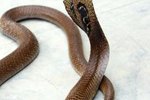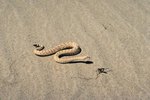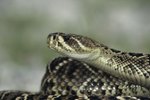
Despite their lack of limbs, snakes display quite the variety of body shapes, from the thickest anaconda to the most slender ground snake. The shape of the head plays a big part in distinguishing different snake species. Evolution has given different snakes varying head shapes to enable them to better adapt to their environment. Snakes with flat heads are typically ground dwellers and often use their heads to burrow through foliage.
Eastern Hognose Snake
This non-venomous snake goes by many pseudonyms, including deaf adder, spreading adder, hiss adder and blow viper. The eastern hognose, which lives mainly in Florida but also inhabits eastern states as far north as Minnesota and even parts of Canada, gets his name from the slightly upturned snout, but his other names point to his ability to scare off potential predators by making himself large and intimidating. When threatened, the eastern hognose will expand its neck to make its already flat head appear larger.
Gaboon Viper
The highly venomous African viper has a distinctly flat head. The flatness of the head enables the gaboon viper to accommodate particularly long fangs, which lie flat in the mouth when the mouth is closed. The head shape also helps them to better blend in when lying on the forest floor.
Tantilla
The tantilla snake is often referred to as the flathead snake, due to the distinctive lack of distinction between head and body. While vipers and many constrictors have distinctly separate heads and necks, the tantilla’s head is so flat that there is almost no distinction between it and the rest of the body. These snakes are small, harmless to humans and prey on small insects. They inhabit forest and woodland throughout most of the United States, but are less abundant in Illinois, where they are considered threatened.
Cobra
Cobras are well known for their distinctive hoods, which they flatten out when attempting to frighten off potential predators. Although the hood and the head are distinct body parts, when the hood is flattened, it does give the appearance of the snake having a flat head.
References
Photo Credits
-
Ryan McVay/Digital Vision/Getty Images
Writer Bio
Simon Foden has been a freelance writer and editor since 1999. He began his writing career after graduating with a Bachelors of Arts degree in music from Salford University. He has contributed to and written for various magazines including "K9 Magazine" and "Pet Friendly Magazine." He has also written for Dogmagazine.net.




